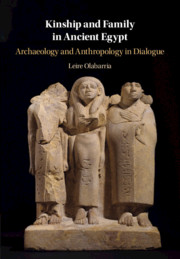Book contents
- Kinship and Family in Ancient Egypt
- Kinship and Family in Ancient Egypt
- Copyright page
- Dedication
- Contents
- Figures
- Acknowledgements
- Map of Egypt
- Part I Ancient Egyptian Kinship in Context
- One Introduction: Ancient Egyptian Kinship between Relatedness and Material Agency
- Two Understanding the Sources
- Three Setting the Terms
- Four Between the Emic and the Etic
- Five Dynamising Kin Groups
- Part II On Koinographic Analysis
- Appendix: ANOC Table
- Notes
- Bibliography
- Index
Two - Understanding the Sources
Dating, Characterisation, Contextualisation and Display
from Part I - Ancient Egyptian Kinship in Context
Published online by Cambridge University Press: 26 February 2020
- Kinship and Family in Ancient Egypt
- Kinship and Family in Ancient Egypt
- Copyright page
- Dedication
- Contents
- Figures
- Acknowledgements
- Map of Egypt
- Part I Ancient Egyptian Kinship in Context
- One Introduction: Ancient Egyptian Kinship between Relatedness and Material Agency
- Two Understanding the Sources
- Three Setting the Terms
- Four Between the Emic and the Etic
- Five Dynamising Kin Groups
- Part II On Koinographic Analysis
- Appendix: ANOC Table
- Notes
- Bibliography
- Index
Summary
Chapter 2 notes the available sources for exploring kinship and marriage in ancient Egypt in the First Intermediate Period and the Middle Kingdom. Decoding modes of display is necessary to discover what monumental sources can reveal about relationships.
In order to assess a possible change in monumental display of social groups from the First Intermediate Period to the Middle Kingdom, the sites of Naga ed-Deir and Abydos are taken as case studies for each of those periods respectively. These sites show that stelae were often grouped into clusters in either tombs or memorial chapels, both sharing a commemorative purpose.
Chapter 2 illustrates the importance of a group approach for stelae in order to extract relevant information about emic constructions of the social fabric. In particular, an alleged clear-cut differentiation between funerary and commemorative stelae is questioned, as these monuments were always mediated through memorial practices. In addition, the articulation of iconographic and inscriptional evidence is shown to provide a more complete assessment of stelae; for example, formulaic phrases often add references to collateral relatives who are not represented iconographically on stelae.
- Type
- Chapter
- Information
- Kinship and Family in Ancient EgyptArchaeology and Anthropology in Dialogue, pp. 24 - 56Publisher: Cambridge University PressPrint publication year: 2020

